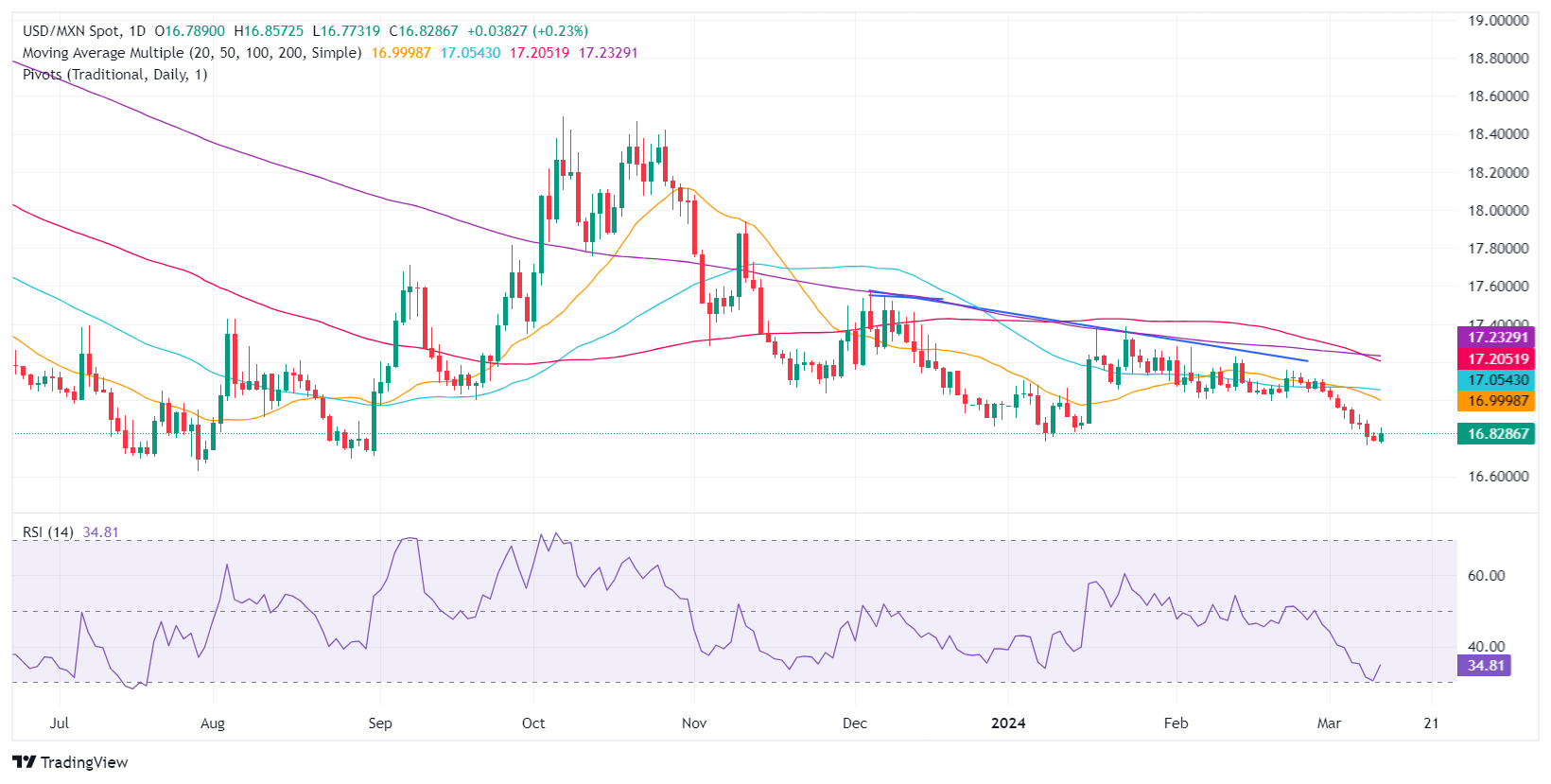- Mexican Peso dips against a strengthening US Dollar after February's US inflation report exceeds expectations.
- Mexico's Industrial Production in January meets forecasts, while US CPI figures push USD/MXN higher.
- Fed's cautious stance on policy easing was underscored by recent inflation trends with eyes on the March meeting.
The Mexican Peso loses some ground on Tuesday against the US Dollar, which appreciated following February’s inflation report in the United States that showcased price level growth remaining stubbornly high. This led to the selling of US Treasuries. Consequently, yields rose, a tailwind for the Greenback. The USD/MXN trades at 16.80, up 0.04%, after hitting a daily low of 16.76.
The National Statistics Agency, INEGI, revealed that Mexico’s Industrial Production in January expanded, aligning with the consensus. In the meantime, the US Bureau of Labor Statistics (BLS) reported that the Consumer Price Index (CPI) for February was higher than expected in annual figures and aligned with forecasts on monthly readings. The Core CPI figures were mixed, with annual figures decelerating, while monthly data stood unchanged compared to January’s number.
The US inflation data, a key factor in the Federal Reserve's policy decisions, has justified the Fed’s stance of being patient regarding easing interest rates. Fed Chair Jerome Powell and his colleagues have expressed the need for more evidence before considering any borrowing cost cuts. The next Fed meeting is scheduled for March 19-20.
Daily digest market movers: Mexican Peso trips down after US CPI
- Mexico’s Industrial Production in January rose by 0.4% MoM as expected, up from -0.7%. In the twelve months to January, production increased by 2.9%, above estimates, smashing December’s 0% reading.
- US CPI in February came at 0.4% MoM, aligned with estimates that were up from 0.3%. Annually based, prices jumped from the 3.1% estimate and the previous reading to 3.2%.
- Core prices expanded 0.4% MoM, unchanged, up from estimates of 0.3% MoM; yet they slowed in the 12 months to February to 3.8% from 3.9%.
- Business activity in the sector segment in the US remained mixed, while Factory Orders plummeted. According to the ADP Employment Change report, the labor market cooled further, even though private hiring remained solid. January’s Nonfarm Payrolls report was revised downward, which triggered a reaction in the swaps market.
- A Reuters poll showed investors estimate the Fed to be the first central bank to cut rates in June.
- Meanwhile, 52 of 108 economists expect the Fed to cut rates by 75 basis points in 2024, with 26 saying 100 bps.
- A Reuters poll sees the Mexican Peso depreciating 7% to 18.24 in 12 months from 16.96 on Monday, according to the median of 20 FX strategists polled between March 1-4. The forecast ranged from 15.50 to 19.00.
- A Reuters poll shows 15 analysts estimate that inflation will slow down in February, corroborating bets that the Bank of Mexico (Banxico) could cut rates as soon as the March 21 meeting.
- Banxico’s private analysts' poll projections for February were revealed. They expect inflation at 4.10%, core CPI at 4.06%, and the economy to grow by 2.40%, unchanged from January. Regarding monetary policy, they see Banxico lowering rates to 9.50% and the USD/MXN exchange rate at 18.31, down from 18.50.
- During Banxico’s quarterly report, policymakers acknowledged the progress on inflation and urged caution against premature interest rate cuts. Governor Victoria Rodriguez Ceja said adjustments would be gradual, while Deputy Governors Galia Borja and Jonathan Heath called for prudence. The latter specifically warned against the risks of an early rate cut.
- Banxico updated its economic growth projections for 2024 from 3.0% to 2.8% YoY and maintained 1.5% for 2025. The slowdown is blamed on higher interest rates at 11.25%, which sparked a shift in three of the five governors of the Mexican Central Bank, who are eyeing the first rate cut at the March 21 meeting.
- The CME FedWatch Tool shows traders increased their bets for a 25-basis-point rate cut in June, down from 72% a day ago to 68%.
Technical analysis: Mexican Peso loses a step as USD/MXN edges high above 16.80
Since falling below the 17.00 figure, the USD/MXN downtrend remains intact. However, it appears that it’s losing steam. As the Relative Strength Index (RSI) studies despite standing in bearish territory, its slope is aiming up, breaking previous lows. This could indicate that buyers are entering the market and opening the door for an upward correction.
Despite that, they need to reclaim the 17.00 figure, which could open the door to testing the 50-day Simple Moving Average (SMA) at 17.04, followed by the confluence of the 200-day SMA and the 100-SMA at 17.23.
On the other hand if the downtrend continues, traders are eyeing a break of the year-to-date low of 16.76, followed by last year’s low of 16.
USD/MXN Price Action – Daily Chart
Mexican Peso FAQs
The Mexican Peso (MXN) is the most traded currency among its Latin American peers. Its value is broadly determined by the performance of the Mexican economy, the country’s central bank’s policy, the amount of foreign investment in the country and even the levels of remittances sent by Mexicans who live abroad, particularly in the United States. Geopolitical trends can also move MXN: for example, the process of nearshoring – or the decision by some firms to relocate manufacturing capacity and supply chains closer to their home countries – is also seen as a catalyst for the Mexican currency as the country is considered a key manufacturing hub in the American continent. Another catalyst for MXN is Oil prices as Mexico is a key exporter of the commodity.
The main objective of Mexico’s central bank, also known as Banxico, is to maintain inflation at low and stable levels (at or close to its target of 3%, the midpoint in a tolerance band of between 2% and 4%). To this end, the bank sets an appropriate level of interest rates. When inflation is too high, Banxico will attempt to tame it by raising interest rates, making it more expensive for households and businesses to borrow money, thus cooling demand and the overall economy. Higher interest rates are generally positive for the Mexican Peso (MXN) as they lead to higher yields, making the country a more attractive place for investors. On the contrary, lower interest rates tend to weaken MXN.
Macroeconomic data releases are key to assess the state of the economy and can have an impact on the Mexican Peso (MXN) valuation. A strong Mexican economy, based on high economic growth, low unemployment and high confidence is good for MXN. Not only does it attract more foreign investment but it may encourage the Bank of Mexico (Banxico) to increase interest rates, particularly if this strength comes together with elevated inflation. However, if economic data is weak, MXN is likely to depreciate.
As an emerging-market currency, the Mexican Peso (MXN) tends to strive during risk-on periods, or when investors perceive that broader market risks are low and thus are eager to engage with investments that carry a higher risk. Conversely, MXN tends to weaken at times of market turbulence or economic uncertainty as investors tend to sell higher-risk assets and flee to the more-stable safe havens.
Information on these pages contains forward-looking statements that involve risks and uncertainties. Markets and instruments profiled on this page are for informational purposes only and should not in any way come across as a recommendation to buy or sell in these assets. You should do your own thorough research before making any investment decisions. FXStreet does not in any way guarantee that this information is free from mistakes, errors, or material misstatements. It also does not guarantee that this information is of a timely nature. Investing in Open Markets involves a great deal of risk, including the loss of all or a portion of your investment, as well as emotional distress. All risks, losses and costs associated with investing, including total loss of principal, are your responsibility. The views and opinions expressed in this article are those of the authors and do not necessarily reflect the official policy or position of FXStreet nor its advertisers. The author will not be held responsible for information that is found at the end of links posted on this page.
If not otherwise explicitly mentioned in the body of the article, at the time of writing, the author has no position in any stock mentioned in this article and no business relationship with any company mentioned. The author has not received compensation for writing this article, other than from FXStreet.
FXStreet and the author do not provide personalized recommendations. The author makes no representations as to the accuracy, completeness, or suitability of this information. FXStreet and the author will not be liable for any errors, omissions or any losses, injuries or damages arising from this information and its display or use. Errors and omissions excepted.
The author and FXStreet are not registered investment advisors and nothing in this article is intended to be investment advice.
Recommended content
Editors’ Picks

EUR/USD drops below 1.0450 as USD gathers strength
EUR/USD stays on the back foot and trades below 1.0450 on Wednesday. The cautious market stance helps the US Dollar (USD) stay resilient against its rivals and weighs on the pair as markets wait for the Federal Reserve to publish the minutes of the January policy meeting.

Gold climbs to new all-time high near $2,950
Gold retreats slightly from the all-time high it touched at $2,947 but manages to stay above $2,930 on Wednesday. The benchmark 10-year US Treasury bond yield clings to modest gains above 4.55%, limiting XAU/USD's upside.

GBP/USD retreats below 1.2600 despite strong UK inflation data
GBP/USD struggles to hold its ground and trades in the red below 1.2600 on Wednesday. Earlier in the day, the data from the UK showed that the annual CPI inflation climbed to 3% in January from 2.5% in December. Market focus shifts to FOMC Minutes.

Maker Price Forecast: MKR generates highest daily revenue of $10 million
Maker (MKR) price extends its gains by 6%, trading around $1,189 on Wednesday after rallying more than 20% so far this week. Artemis data shows that MKR generated $10 million in revenue on February 10, the new yearly high in daily revenue.

Money market outlook 2025: Trends and dynamics in the Eurozone, US, and UK
We delve into the world of money market funds. Distinct dynamics are at play in the US, eurozone, and UK. In the US, repo rates are more attractive, and bills are expected to appreciate. It's also worth noting that the Fed might cut rates more than anticipated, similar to the UK. In the eurozone, unsecured rates remain elevated.

The Best Brokers of the Year
SPONSORED Explore top-quality choices worldwide and locally. Compare key features like spreads, leverage, and platforms. Find the right broker for your needs, whether trading CFDs, Forex pairs like EUR/USD, or commodities like Gold.
